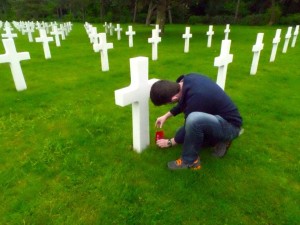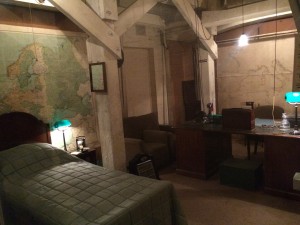To the unobservant eye, Berlin is just a city filled with nice buildings, a beautiful river, good food, and friendly people. Just under the surface, though, Berlin is a city that deals with a dark past. From the Nazi era to the Berlin Wall, Berliners face the challenge of acknowledging their dark past while still moving forward.
While walking through the city, I could not get very far without seeing something to remind me of World War II of the Cold War. On a simple walk down the street, I would any combination of gold plaques on the sidewalk marking the locations where Jews were deported to concentration camps, the façade of a train station that had been bombed, pieces of the Berlin wall that still stand or had been transferred for display, or a cobblestone line marking where the wall had once stood. Berlin also has museums that address World War II, the holocaust, and the role of the Gestapo and SS in Nazi Germany.
Overall, I think Berliners have done a good job acknowledging their history while still moving past it to brighter times. This was especially evident to me when I saw how the city handled the remnants of the Berlin wall. Instead of completely destroying the wall and trying to forget about it, there is a strong effort to remember the history of it and the reasons why it was built. I was both surprised and impressed by this. It can be difficult for people to recognize and acknowledge darker times that they or their ancestors were responsible for. Berlin does not try to hide from their history though. Instead, through displays, informational panels, and museums, they embrace their history.
While they do not try to turn it into a spectacle, Berlin does not try to hide their role during the Nazi era. I learned this through the Topography of Terror museum and the placement of plaques throughout the streets to remember the people who were deported from those sites. I made me uneasy every morning when I would walk outside of the hotel and immediately see those plaques. The spot where I began my day was the same spot where others’ lives were torn apart. It was difficult to comprehend the horrors took place where my hotel now stands. The Topography of Terror museum shows pictures and provides information of the Gestapo and SS’s roles during the holocaust. The museum fully acknowledges the roles Germans played in the Holocaust. It does not try to make excuses. Many other countries I visited seemed to point blame at another group and did not take ownership for their actions as well as the Germans did.
Being in Berlin was a bizarre experience. I was standing in a modern city while surrounded by so much history. I could go from looking at a brand new building to seeing the Berlin wall to seeing a plaque or memorial from World War II in under five minutes. This made Berlin fascinating city, and I feel like there is still much to be discovered from it.
Erik Smith








